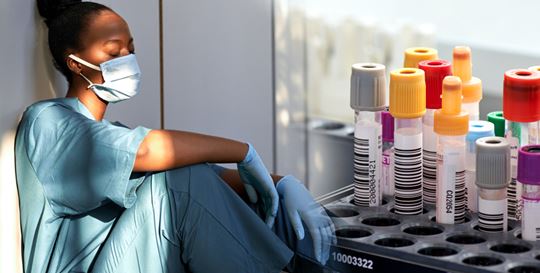Antibiotic Resistance, One of the Greatest Global Health Challenges
Antibiotic resistance is one of the greatest global challenges of modern time. According to a 2020 Center for Disease Control estimate, there are 2.8 million antibiotic-resistant infections in the U.S. annually and at least 35,000 deaths every year.1
Antibiotic resistance has an impact on a variety of industries including healthcare, veterinary health and agriculture, making it one of the world’s most urgent public health problems. Fighting the threat requires a collaborative approach across academia, industry, healthcare and the general population.
According Dr. Jean Patel, principal scientist, scientific affairs at Beckman Coulter, the threat of antimicrobial resistance is growing and is a significant public health threat today because bacteria are becoming resistant to many drugs.
"We used to see bacteria that were resistant to one drug, and there were always several other drugs that could treat the infection," she explained. "But today, we have bacteria that are causing infections that are resistant to nearly all drugs that are considered for treatment—it’s a very serious clinical issue."
Additionally, the problem is global because antimicrobial resistance may occur on a genetic element that can transfer from one bacterium to another.
"Because we can see hopping of resistance from one bacterium to another, we can see both amplification of resistance and spread," said Dr. Patel, "When we learn about new types of resistance in one part of the world, very quickly we find that it has spread to other parts of the world and now all patient populations are affected," she added.
Antibiotic Use During the Pandemic Era
The COVID-19 pandemic has also had an impact on antibiotic resistance because it’s been challenging for doctors to differentiate patients that need antibiotics from those that don’t. It’s estimated that 72% of COVID-19 patients are receiving antibiotics when only 8% of patients have co-infection.2
“Because patients present with acute symptoms that might be viral or bacterial, early treatment has been critical, and patients have been treated with antibiotics even if they had a viral infection,” said Dr. Patel. “Doctors are having to make quick decisions to treat patients, trying to save lives, and oftentimes these decisions are made before testing can be performed.”
For those patients who are hospitalized with COVID-19, they are at added risk because they are at risk of developing healthcare associated infections which are usually very resistant infections.
There isn’t much testing of these patients either because it’s hard to get specimens from patients that are quarantined. “That means that patients are getting antibiotics without a lot of laboratory testing which can lead to more resistance,” Dr. Patel indicated.
The bottom line is that if antibiotics are overused and laboratory testing isn't part of the equation, then we will see more antimicrobial resistance emerging in the coming months.
Increasing Pressure to Deliver Quality Care
The pandemic has put increasing pressures on labs in recent months and microbiology labs are no exception. Labs that did not provide COVID-19 testing previously have had to take on additional workload and even the most experienced microbiologists have reported feeling stressed, overwhelmed, and physically and mentally fatigued over the course of the pandemic.
This is all taking place while microbiology labs face staffing shortages. According to The American Society for Clinical Pathology’s 2018 Vacancy Survey of Medical Laboratories in the U.S., there’s an estimated 17% retirement rate amongst laboratory professionals in the next several years and an 11% vacancy rate for these positions.3
"Skilled microbiology laboratorians are already a dwindling resource, the stress and the strain of the testing needed to address COVID-19 is accelerating the retirement rate for these professionals, said Dr. Patel, "that means that the laboratories must implement testing that is easiest to perform with the staff that they have on hand."
Ancillary Antibiotic Susceptibility Testing is Becoming Routine Practice
Antimicrobial Susceptibility Testing (AST), a procedure used to determine which antibiotics a specific organism or group of organisms are susceptible to, has become a routine practice for some labs.
In this process, pathogens isolated from clinical specimens are identified to confirm medical diagnoses and to guide antimicrobial therapy to ensure the correct antibiotics are used and avoid using antibiotics that the pathogen may be resistant to.
“Ancillary antibiotic testing is not good for the patient or for the laboratory,” said Dr. Patel, “It means there is additional testing needed beyond what's done on the automated system to manage patients and it adds time before test results are done.”
Ancillary AST testing results in hidden costs, workflow disruption and delayed reporting. It takes up valuable resources, both personnel time and its overall more costly for laboratories to support.
It can add 24 hours or more to the time when results are available for the patient. It therefore increases the potential of delayed appropriate therapy. This can increase the risk of in-hospital mortality or discharge to hospice by 20%, increase in length of stay by 70% and increase total in-hospital costs by 65%. This could potentially cost hospitals over $11,000 per infection.4
Effective Testing Supports Clinical Utility
In the end, what’s best for microbiology labs is an effective testing strategy that supports clinical utility. This enables improved efficiency in clinical decision making, streamlines clinical workflow, which results in better patient outcomes. It also results in cost offsets or avoidance.
Detection of antimicrobial resistance is more crucial than ever before. How can labs get a hold of more effective testing in their labs to support clinical utility during the most pressing times?
MicroScan Provides Antimicrobial Resistance Detection
Beckman Coulter’s MicroScan provides more first-time reportable results than other automated methods. The system focuses on accuracy over speed with overnight incubation that optimizes the detection of antimicrobial resistance.
Using direct testing methodology, results are based on how organisms react today – and not on historical information; additionally, microbiology results are not guided by organism identification. The system is visual read compatible, which means visual confirmation of unusual results ensures confidence and minimizes repeat testing.

 English
English






